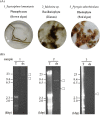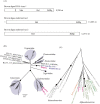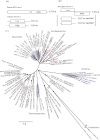Viral RNA Genomes Identified from Marine Macroalgae and a Diatom
- PMID: 32554943
- PMCID: PMC7511793
- DOI: 10.1264/jsme2.ME20016
Viral RNA Genomes Identified from Marine Macroalgae and a Diatom
Abstract
Protists provide insights into the diversity and function of RNA viruses in marine systems. Among them, marine macroalgae are good targets for RNA virome analyses because they have a sufficient biomass in nature. However, RNA viruses in macroalgae have not yet been examined in detail, and only partial genome sequences have been reported for the majority of RNA viruses. Therefore, to obtain further insights into the distribution and diversity of RNA viruses associated with marine protists, we herein examined RNA viruses in macroalgae and a diatom. We report the putative complete genome sequences of six novel RNA viruses from two marine macroalgae and one diatom holobiont. Four viruses were not classified into established viral genera or families. Furthermore, a virus classified into Totiviridae showed a genome structure that has not yet been reported in this family. These results suggest that a number of distinct RNA viruses are widespread in a broad range of protists.
Keywords: RNA virus; algae; dsRNA.
Figures





Similar articles
-
New single-stranded DNA virus with a unique genomic structure that infects marine diatom Chaetoceros setoensis.Sci Rep. 2013 Nov 26;3:3337. doi: 10.1038/srep03337. Sci Rep. 2013. PMID: 24275766 Free PMC article.
-
Molecular characterization of a novel partitivirus isolated from the phytopathogenic fungus Aplosporella javeedii.Arch Virol. 2021 Apr;166(4):1237-1240. doi: 10.1007/s00705-021-04988-1. Epub 2021 Feb 9. Arch Virol. 2021. PMID: 33560459
-
A novel mycovirus isolated from the plant-pathogenic fungus Botryosphaeria dothidea.Arch Virol. 2021 Apr;166(4):1267-1272. doi: 10.1007/s00705-021-04983-6. Epub 2021 Feb 17. Arch Virol. 2021. PMID: 33598815
-
Dinoflagellates, diatoms, and their viruses.J Microbiol. 2008 Jun;46(3):235-43. doi: 10.1007/s12275-008-0098-y. Epub 2008 Jul 5. J Microbiol. 2008. PMID: 18604491 Review.
-
The possibility of using marine diatom-infecting viral promoters for the engineering of marine diatoms.Plant Sci. 2020 Jul;296:110475. doi: 10.1016/j.plantsci.2020.110475. Epub 2020 Mar 20. Plant Sci. 2020. PMID: 32540005 Review.
Cited by
-
RNA Virosphere in a Marine Zooplankton Community in the Subtropical Western North Pacific.Microbes Environ. 2022;37(5):ME21066. doi: 10.1264/jsme2.ME21066. Microbes Environ. 2022. PMID: 34980753 Free PMC article.
-
Revealing RNA virus diversity and evolution in unicellular algae transcriptomes.Virus Evol. 2021 Aug 14;7(2):veab070. doi: 10.1093/ve/veab070. eCollection 2021 Sep. Virus Evol. 2021. PMID: 36819971 Free PMC article.
-
RNA Viruses in Aquatic Ecosystems through the Lens of Ecological Genomics and Transcriptomics.Viruses. 2022 Mar 28;14(4):702. doi: 10.3390/v14040702. Viruses. 2022. PMID: 35458432 Free PMC article. Review.
-
Metatranscriptomic Identification of Diverse and Divergent RNA Viruses in Green and Chlorarachniophyte Algae Cultures.Viruses. 2020 Oct 19;12(10):1180. doi: 10.3390/v12101180. Viruses. 2020. PMID: 33086653 Free PMC article.
-
Diverse RNA Viruses Associated with Diatom, Eustigmatophyte, Dinoflagellate, and Rhodophyte Microalgae Cultures.J Virol. 2022 Oct 26;96(20):e0078322. doi: 10.1128/jvi.00783-22. Epub 2022 Oct 3. J Virol. 2022. PMID: 36190242 Free PMC article.
References
-
- Darissa O., Willingmann P., and Adam G. (2010) Optimized approaches for the sequence determination of double-stranded RNA templates. J Virol Methods 169: 397–403. - PubMed

